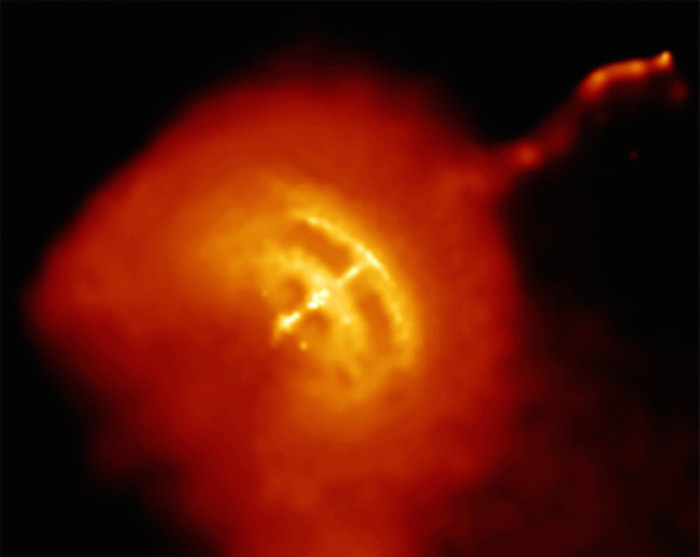.

An image of the Vela pulsar (which lies at the heart of the Vela supernova remnant) in which glitching has been observed. The pulsar itself is the bright white spot at the centre of the hot gas, and a jet powered by its rotational pole is also observed in this Chandra X-ray Observatory image. (Courtesy: NASA/CXC/PSU/G Pavlov et al.)
.
Pulsars are known to be the most precise cosmic timekeepers, but occasional "glitches" or a sudden increase in their spin rate disrupts the stars' otherwise regular behaviour. A new study of the glitching process by an international team of researchers suggests that superfluid matter in the core of a pulsar may cause the poorly understood effect. The work combines radio and X-ray data to determine pulsar masses, and successfully explains glitches that are documented in 45 years' worth of observational data.
Pulsars are highly magnetized, rapidly rotating neutron stars that emit "pulses" of broadband electromagnetic radiation at very regular intervals. Born in the collapse and subsequent supernova explosion at the end of a massive star's life, pulsars are small and extremely dense. They normally have a radius of about 25 km and a mass greater than that of the Sun. They are mainly made up of neutron-rich matter that is tightly packed at densities greater than that of an atomic nucleus.
Speed up or slow down?
The spin periods of observed pulsars range between 1.4 ms and more than 1 s, but their rotation periods are normally exceedingly stable. Indeed, many pulsars rival the precision of an atomic clock. A pulsar's rotation period is also known to decrease with time, as it loses energy through electromagnetic radiation. But in many young pulsars, this long-term slowdown is occasionally interrupted by a sudden increase in speed, called a glitch. After the speed-up, which can occur in less than one minute, the pulsar gradually returns to its previous speed, but this can take up to about a year. Just as rotation speeds vary from pulsar to pulsar, the magnitude of the speed-up can also be different for different pulsars.
Our current understanding of pulsar dynamics suggests that glitches occur because of some interaction between superfluid matter and normal matter within the star. Pulsar structure comprises three different regions – the outer crust, the inner crust and the core. While the core is made up of free neutrons in a liquid state, the inner crust contains neutron-rich nuclei swimming in a sea of free neutrons, which are expected to be in a superfluid state.
Spin reservoir
While the rest of the pulsar slows down, the superfluid does not – instead it acts as a reservoir of angular momentum. Previous theoretical models work on the principle that, when the difference in speeds between the superfluid and the rest of the pulsar reaches a critical (but currently unknown) value, the superfluid transfers some of its angular momentum to the normal matter, thus jolting the pulsar and making its speed of rotation increase. However, more recent work has shown that there is a sizable amount of uncertainty in this theory because the amount of superfluid available in the crust is not enough to create the glitch – a lot more would be required.
Using computer simulations, Wynn Ho of the University of Southampton in the UK, together with colleagues in Chile and Netherlands, has taken a closer look at pulsar superfluity and developed a model wherein the glitches gain the necessary momentum by tapping into the superfluid core. "We used the best current models of superfluids and pulsars, which are based on nuclear-physics experiments and calculations, to calculate how strong glitches should be as a pulsar ages," explains Ho. "The age is important because the amount of superfluid in a pulsar depends on its temperature, and thus as the pulsar ages, it cools, and more of it becomes superfluid."
Weighing up
Ho told physicsworld.com that while glitches are seen primarily in radio data, they also crop up in X-ray data, which gives the pulsar's temperature. By comparing a pulsar's observed temperature and glitch size, the researchers can also measure its mass. "This last point is what is really exciting about our work, because it allows us to measure the pulsar's mass even if it is not in orbit near another star or planet," says Ho. "Or in other words, we can measure mass using nuclear physics, not gravity. This is also extremely useful because most pulsars are isolated stars, not in binary systems." The ability to measure the masses of such lone pulsars has not been demonstrated before.
In their latest work, the researchers looked at glitches in nine pulsars, but they plan to look at more with their new model in the months to come. Ho and colleagues hope that their research inspires more theoretical work on superfluids and promotes connections between astronomers and nuclear physicists. "We think that the potential of the Square Kilometre Array to discover and monitor many more pulsars could really help to revolutionize our understanding in the respective fields of study," says Ho.
Quelle: Physics World
4936 Views
